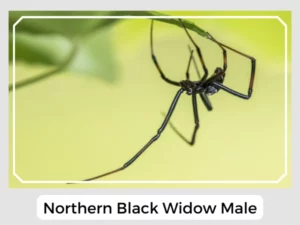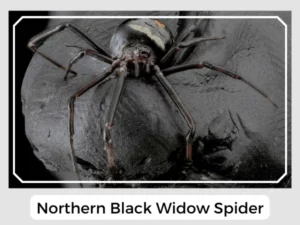The Northern Black Widow is a cool spider found mainly on the ‘East Coast’ of North America. It’s a close relative to the southern and western black widows. Female spiders from this group are really strong and make amazing 3D webs out in nature. Ready to discover more about them? Keep reading!
The females lay approximately up to 200 eggs that they incubate for around three weeks in a small, round, brown, papery sac that remains attached to the mother’s web.
Like the males, the juveniles and immature specimens have two pairs of diagonal whitish bands on both sides of the abdomen. After hatching, the baby spiders remain in the cocoon for around four weeks. They are taken care of by the mother until they are mature enough to forage for themselves.
Yes, Northern Black Widow Spiders have venom. They use it mostly to catch the bugs they like to eat.
While the venom of widow spiders is 15 times stronger than rattlesnakes’, they rarely bite as they are shy and prefer to run away when threatened. Even if bitten, the small amount of venom means it’s usually not deadly, with only a 1% mortality rate. Bites cause immediate pain, and redness, and can hurt for up to 24 hours.
Northern Black Widows are important predators in their habitats. They control insect populations, which could otherwise become pests. Their impressive three-dimensional webs are not just for catching prey but also serve as protective structures for their offspring. They are shy by nature and exhibit remarkable maternal care.
Natural Predators: These spiders face predation from birds and larger spiders. This predation is a natural control on their populations, ensuring they do not become too numerous.
Prey-Predator Dynamics: The Northern Black Widow feeds primarily on insects but will also consume smaller spiders and arthropods. This diet makes them an integral part of the food web, controlling the insect population and providing food for their predators.
Relationship with Humans: While the Northern Black Widow’s venom is potent, they are timid and bites are rare. When they do occur, bites can be painful but are seldom fatal thanks to the small amount of venom injected. They prefer undisturbed natural habitats but can sometimes be found in human-inhabited areas, where their pest control benefits are welcomed.
| Other Names | Northern widow |
| Lifespan | 1 to 3 years |
| Distribution | Ranges from northern Florida to south-eastern Canada |
| Habitat | Mostly prefer undisturbed woods, stumps, and stone walls |
| Common predators | Birds of prey, larger spiders |
| Diet | Mostly insectivorous, but might prey upon other smaller spider species and non-insect arthropods as well |

In conclusion, the Northern Black Widow is a species that, despite its fearsome reputation, contributes significantly to the ecological balance through its predatory habits.

The Northern Black Widow is a cool spider found mainly on the ‘East Coast’ of North America. It’s a close relative to the southern and western black widows. Female spiders from this group are really strong and make amazing 3D webs out in nature. Ready to discover more about them? Keep reading!
The females lay approximately up to 200 eggs that they incubate for around three weeks in a small, round, brown, papery sac that remains attached to the mother’s web.
Like the males, the juveniles and immature specimens have two pairs of diagonal whitish bands on both sides of the abdomen. After hatching, the baby spiders remain in the cocoon for around four weeks. They are taken care of by the mother until they are mature enough to forage for themselves.
Yes, Northern Black Widow Spiders have venom. They use it mostly to catch the bugs they like to eat.
While the venom of widow spiders is 15 times stronger than rattlesnakes’, they rarely bite as they are shy and prefer to run away when threatened. Even if bitten, the small amount of venom means it’s usually not deadly, with only a 1% mortality rate. Bites cause immediate pain, and redness, and can hurt for up to 24 hours.
Northern Black Widows are important predators in their habitats. They control insect populations, which could otherwise become pests. Their impressive three-dimensional webs are not just for catching prey but also serve as protective structures for their offspring. They are shy by nature and exhibit remarkable maternal care.
Natural Predators: These spiders face predation from birds and larger spiders. This predation is a natural control on their populations, ensuring they do not become too numerous.
Prey-Predator Dynamics: The Northern Black Widow feeds primarily on insects but will also consume smaller spiders and arthropods. This diet makes them an integral part of the food web, controlling the insect population and providing food for their predators.
Relationship with Humans: While the Northern Black Widow’s venom is potent, they are timid and bites are rare. When they do occur, bites can be painful but are seldom fatal thanks to the small amount of venom injected. They prefer undisturbed natural habitats but can sometimes be found in human-inhabited areas, where their pest control benefits are welcomed.
| Other Names | Northern widow |
| Lifespan | 1 to 3 years |
| Distribution | Ranges from northern Florida to south-eastern Canada |
| Habitat | Mostly prefer undisturbed woods, stumps, and stone walls |
| Common predators | Birds of prey, larger spiders |
| Diet | Mostly insectivorous, but might prey upon other smaller spider species and non-insect arthropods as well |

In conclusion, the Northern Black Widow is a species that, despite its fearsome reputation, contributes significantly to the ecological balance through its predatory habits.
